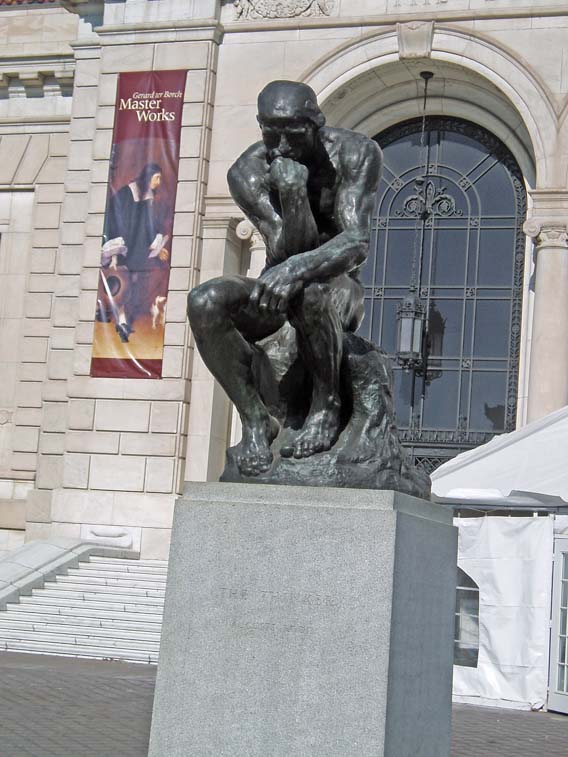
The Thinker
In front of the Detroit Institute of Art
5200 Woodward Avenue in Detroit’s Cultural Center
Auguste Rodin, born in Paris in 1840 to Jean-Baptiste Rodin and Marie Cheffer, was a talented young artist from a low-income family. He studied at Ēcole Speciale de Dessin et de Mathématique, then a leading school of design. Three times he applied to and three times he was rejected for admission to the Ēcole des Beaux Arts, the leading school of art in Paris. Quite likely, at that time, it was the leading center for the training of artists in the entire world. Rodin began his career as an artist and sculptor working for commercial decorators and ornamental designers in Paris. He also was employed in the productive and creative studio of Carrier-Belluse, the firm that won commissions to design many public monuments in Belgium.
This was a favorable time to be a creative artist in Paris. Baron von Haussmann was creating the city of Paris with its broad boulevards, monuments and massive public buildings that we visit today. Throughout the prosperous countries of Western Europe, funds were available to create public buildings, gardens, museums, zoos and memorable sculptures commemorating the accomplishments of classical and western civilization.
In 1875 or so, Rodin traveled to Italy and appreciated, presumably for the first time, the achievement of Botticelli Donatello, Gilbert and Michelangelo. In an important sense, Rodin’s time in Italy revived an interest in France in large sculptures depicting heroic figures.
In the late Nineteenth Century, European intellectuals rediscovered the importance of Dante’s poetry. One illustration of that is the statue of Dante erected on Belle Isle by Detroit’s Italian community. Dante is, arguably, the most talented poet of our era. By the late Nineteenth Century—well after their unfortunate war with Germany in 1870—rapid economic growth attributable to industrialization and empire building created the prosperity that permitted the French government to create the modern City of Light. Other cities in France also had ample funds to commission large public buildings with much sculpture providing many opportunities for Rodin and other artists. The French Ministry of Fine Arts, in 1880, decided to erect a Museum of Decorative Art in Paris. The officials decided that the main entryway should commemorate Dante’s Divine Comedy. Auguste Rodin, by then one of the most prominent sculptors in the world, was commissioned to design entryway portals using the theme of Gates of Hell from Dante’s Inferno. Dante produced small-scale models of the sculptures he would install, but by the late 1880s, the French government terminated their plans for a new museum.
In 1900, a Paris World Exposition was organized. This was the era when World Fairs were frequently organized to illustrate the cultural and manufacturing achievements of a country and to generate tourism in the host city. The Chicago Exposition of 1893 is, perhaps, the best known such world’s fair in the Great Lakes area, but there were many such events. By 1900, Rodin was recognized for his outstanding achievements and, I believe, a major hall was devoted to his works at the Paris World Exposition.
At some point after 1905, Auguste Rodin moved his studio and his residence to the Hôtel Biron. This had been a religious institution but the French government enacted a separation of church and state law in 1905 and the building was taken over by the city government. Shortly thereafter, a variety of other creative artists moved their studios into the building that Auguste Rodin popularized. By this time, Rodin had decided to complete one of the statues that he had designed for the never-built Museum of Decorative Art. This was The Thinker, a cast of which graces Woodward Avenue.
In 1912, the Parisian government decided to raze the Hôtel Biron. This is a beautiful classic structure designed by Jacques Gabriel and built between 1728 and 1732. Rodin—and many other preservationists—thought that was a terribly bad idea to tear down such a great structure. Rodin decided to offer The Thinker and other sculptures to the city if they would allow him to use the Hôtel Biron for the rest of his life and then would convert the attractive building and its grounds into a sculpture museum. The city agreed, Rodin died in 1917 and, since 1919, the Hôtel Biron has been the Musée Auguste Rodin.
I believe that about 20 copies were made of Rodin’s original composition, perhaps in 1904 when this work was installed in Paris. The one here, I think, was produced for Dr. and Mrs. Linde of Lubeck, Germany. At some point, Horace Rackham, whose name is attached to the nearby University of Michigan Building in Detroit’s Cultural Center, donated this copy of The Thinker to the Detroit Institute of Art. The DIA has five other sculptures by Auguste Rodin.
Sculptor: Auguste Rodin
Date of Original Casting: 1904
Substance: Bronze
Base: Granite
Use in 2011: Public Art
Short biography of Auguste Rodin: http://www.cantorfoundation.org/Rodin/rbioe.html
Website for Musée Auguste Rodin: http://www.musee-rodin.fr/fr
City of Detroit Designated Historic District: Not listed
State of Michigan Registry of Historic Sites: The campus of the Detroit Institute of Art is within the Cultural Center Historic District, #P25,056.
National Register of Historic Places: The campus of the Detroit Institute of Art is within the Cultural Center Historic District, #83003791 listed November 21, 1983.
Picture: Ren Farley
Description prepared: December, 2011